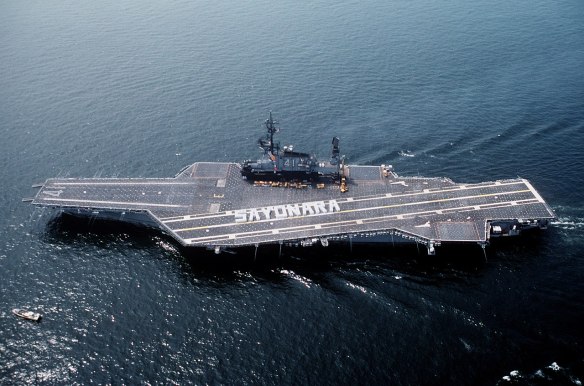
The US navy’s desire for an armoured flight deck came about due to the reports before America’s official entry into the Second World War of the ability of Royal Navy carriers fitted with armoured flight decks to absorb a great deal of punishment in battle and continue to function. An added benefit in fitting the next generation of US navy fleet carriers with armoured flight decks would be their ability to bear the weight of the upcoming generations of larger and heavier carrier aircraft.
Congress authorized the building of six new fleet carriers in June 1942. They were to be designated the Midway class and assigned the letter suffix designation code `CVB’, with the letter `B’ standing for `battle’. However, only the first three were built, all being commissioned following the end of the Second World War. These were the USS Midway (CVB-41), USS Franklin D. Roosevelt (CVB-42) and USS Coral Sea (CVB-43).
The Midway-class carriers had an overall length of 968 feet and a full load displacement of 55,000 tons. The ship’s armoured flight deck was 3.5 inches thick and was considered part of the superstructure. Its hangar deck was considered the main deck, or strength deck, as it had been on the previous Essex-class carriers. The hangar deck on the Midway class was unarmoured to save weight.
The Midway-class carriers had been intended to carry as many as 144 aircraft that would be launched with the assistance of two hydraulically-operated flight deck catapults. As carrier aircraft became ever larger and heavier in the post-war years, the number of planes carried on board the ships dropped. At face value it might seem that the smaller number of aircraft would lessen the carrier’s effectiveness but the newer generation of aircraft was much more capable than their predecessors, offsetting the decline in numbers. Planes on the ships were moved between the flight and hangar decks by two centreline and one port-side deck-edge elevator.
The USS Franklin D. Roosevelt was the initial US navy carrier modified to handle nuclear weapons in 1950. The first US navy aircraft able to carry a nuclear weapon and be launched from a Midway-class carrier was a modified land-based, twin-engine patrol aircraft designated the P2V. Twelve were modified for the role and designated the P2V-3C. Due to the size of the P2V-3C they were not intended to be recovered by the Midway-class carriers. They were a stopgap solution until the specially designed AJ-1 Savage entered service, which occurred in late 1949. It was designed to be both launched and recovered from Midway-class carriers.
In 1952 the US navy redesignated the Midway-class carriers as CVAs rather than CVBs, the letter `A’ now standing for `attack’. In 1975 the US navy redesignated the Midway-class carriers once again and they now became just CVs.
As with many of the Essex-class carriers, the three Midway-class carriers also went through modernization programmes, beginning in 1953 with the USS Franklin D. Roosevelt. The programmes were referred to as Project SCB-110 and Project SCB-110A and provided the ships with angled flight decks and other improvements such as an enclosed hurricane bow.
The first Midway-class carrier to return to service with the Project SCB-110 and Project SCB-110A upgrades was the USS Franklin D. Roosevelt in 1956, followed by the USS Midway in 1957 and the USS Coral Sea in 1960.
As the march of technology continued in naval aviation the Midway-class carriers, like those that went before them, were unable to operate the latest generation of larger and heavier carrier aircraft. By the 1970s, they were also just old and worn out and a massive conversion was not cost-effective. It was therefore decided to retire the three Midway-class carriers. The first to go was the Franklin D. Roosevelt in 1977, the Coral Sea in 1990 and the Midway in 1992, the latter having a second career as a museum ship berthed in San Diego Harbor since 2004.